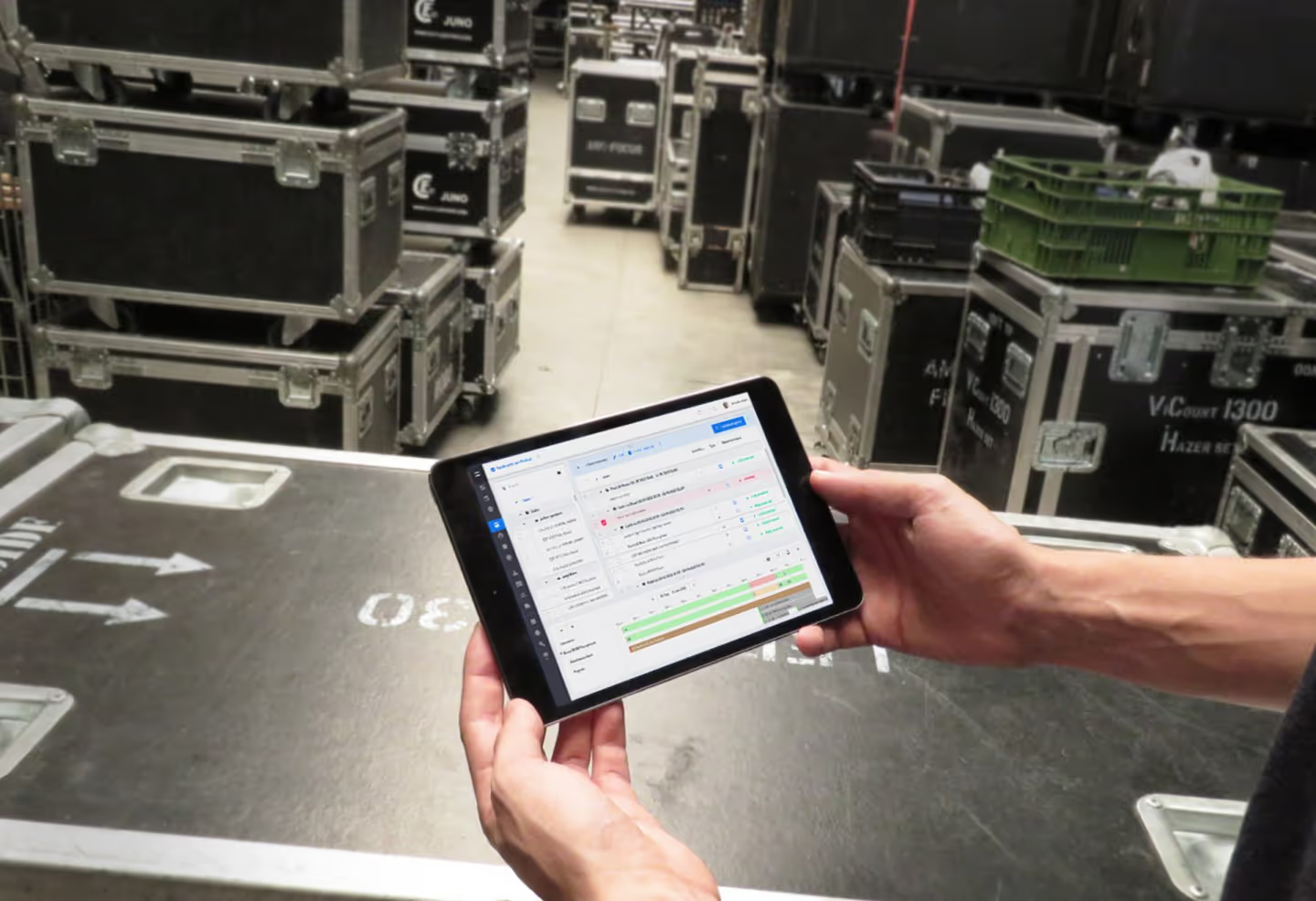The Asset Tag System for Events and Media Productions

Effective asset management is crucial in the dynamic and equipment-intensive industries of events and media production. This is where an asset tag system comes into play, offering a streamlined process and solution for tracking, managing, and safeguarding valuable assets.
This article will delve into the importance, implementation, and benefits of an asset tag system, providing insights tailored specifically for professionals in the events and media production industries.
1. What is an Asset Tag System?
2. Best Asset Label for Events and Media Productions
3. Importance of Asset Tagging in Events and Media Productions
4. Implementing an Asset Tag System
5. Benefits of an Asset Tag System in Events and Media Productions
6. Advanced Asset Tagging System
7. Case Studies: Asset Tagging in Action
8. Future Trends in Asset Tagging
9. Conclusion
What is an Asset Tag System?
An asset label system is an organized approach to tracking and managing physical assets by attaching durable tags to equipment and other items. These tags typically feature unique identifiers, such as barcodes, QR codes, or RFID (Radio Frequency Identification) technology, which can be scanned to capture and record asset information.
The system is supported by an asset tracking system—a software platform that stores and manages the data collected from these tags. This setup ensures that every piece of equipment is accounted for and its details are easily accessible, enhancing the overall efficiency and prevent theft.
Components of an Asset Tag System
An effective asset tag system consists of several key components:
- Asset Tags: These are durable asset labels or tags that are physically attached to equipment. They are designed to withstand various environmental conditions and typically feature barcodes, QR codes, or RFID technology to enable easy scanning and identification.
- Asset Tracking System: This is the software that serves as the backbone of the asset tag system. It records, monitors, and manages all asset-related information, such as locations, maintenance schedules, and usage history. The software provides a centralized database that can be accessed by authorized personnel to track and manage assets efficiently.
- Scanning Devices: These tools are used to read the information encoded in asset tags. Barcode scanners, RFID readers, and smartphones equipped with QR code scanning capabilities are common devices used in an asset tag system. These devices facilitate the quick and accurate capture of asset data.
By integrating these components, an asset tag system provides a comprehensive solution for tracking and managing physical assets, ensuring they are properly accounted for and maintained throughout their lifecycle.
Types of Asset Tags
There are various types of asset tags available, each designed to meet specific needs and environmental conditions. Some of the most common types include:
- Barcode Labels: Simple and cost-effective, barcode labels are widely used for tracking assets in controlled environments. They are easy to produce and scan, making them a popular choice for many organizations.
- QR Codes: These two-dimensional barcodes can store more information than traditional barcodes and can be scanned using smartphones. QR codes are versatile and can be used for a wide range of asset-tracking applications.
- RFID Tags: RFID technology uses radio waves to communicate between the tag and a reader. These tags can be read from a distance and do not require direct line-of-sight scanning, making them ideal for tracking assets in large, busy environments.
- Tamper-Evident Tags: Designed to show visible signs of tampering, these tags enhance security by indicating if an asset has been accessed or moved without authorization. They are commonly used for high-value or sensitive equipment.
- Durable Asset Tags: Made from materials that can withstand harsh conditions, such as extreme temperatures, moisture, and abrasion, durable asset tags are used for assets located in demanding environments.
Each type of asset tag has its advantages and is suitable for different scenarios. Choosing the right type of tag depends on factors such as the value of the asset, the environment in which it will be used, and the level of security required.
Best Asset Label for Events and Media Productions
Selecting the best asset label for your specific needs is crucial for the effectiveness of your asset tag system. In the events and media production industries, the requirements for asset labels can vary widely depending on the type of equipment, the environments in which they are used, and the specific tracking needs. Here are some key considerations and recommendations for choosing the best asset label for your operations.
Key Considerations for Choosing Asset Labels
- Durability: Asset labels need to withstand the rigors of the environments in which they are used. For example, equipment used in outdoor events may be exposed to extreme weather conditions, while media production equipment might encounter frequent handling and transport. Choose labels that are made from durable materials, such as polyester or metal, and are resistant to abrasion, moisture, and UV light.
- Adhesive Strength: The adhesive on asset labels must be strong enough to remain attached to the equipment over time, even under harsh conditions. Consider using high-bond adhesives that provide a strong and lasting attachment to various surfaces, including metal, plastic, and rough textures.
- Readability: The information on asset labels must be easily readable to ensure quick and accurate scanning. High-contrast printing and clear fonts are essential, and labels should be large enough to accommodate all necessary information, including barcodes, QR codes, or RFID tags.
- Security Features: For high-value assets, consider using tamper-evident labels that show visible signs of tampering if someone attempts to remove or alter the label. This can help deter theft and unauthorized use of equipment.
- Compatibility: Ensure that the labels you choose are compatible with your existing asset tracking system and scanning devices. For instance, if you are using RFID technology, select RFID-compatible labels.
- Environmental Conditions: Consider the specific environmental conditions in which the labels will be used. For example, if the equipment is exposed to high temperatures, chemicals, or water, choose labels designed to withstand these conditions.
Importance of Asset Tagging in Events and Media Productions
Enhanced Asset Visibility
In the events and media production industries, asset visibility is critical. Asset tags offer real-time location tracking, ensuring that equipment is accounted for at all times. This visibility reduces the risk of loss and theft, common issues in environments where equipment is frequently moved.
Efficient Inventory Control
Managing a large inventory of equipment can be challenging. An asset tag system simplifies inventory control by providing accurate and up-to-date information about each piece of equipment. This system can track company assets across multiple locations, making it easier to manage inventory at various job sites.
Improved Maintenance Management
Keeping equipment in optimal condition is essential for seamless production. Asset tags help managing assets, tracking maintenance schedules and record the maintenance history of each asset, ensuring timely servicing and reducing downtime due to equipment failure.
Cost Savings
By preventing loss, reducing theft, and optimizing maintenance, an asset tag system can lead to significant cost savings. It helps avoid unnecessary equipment purchases and repairs, making it a cost-effective solution for asset management.
Implementing an Asset Tag System
- Identify Assets: Determine which assets need to be tagged. Focus on high-value assets, moveable assets, and any equipment critical to production.
- Choose the Right Asset Tags and Asset Labels: Select tags based on the environment and type of asset. For example, use tamper-evident tags for security or durable labels for harsh environments.
- Attach Asset Tags: Securely tag assets. Ensure they are easily accessible for scanning but not easily removable.
- Configure the Asset Tracking System: Set up the software, inputting details about each asset, such as serial number, location, and maintenance schedule.
- Train Staff: Educate employees on the asset tagging process and how to use the tracking system effectively.
- Regularly Update Records: Keep the asset register updated with any changes, such as new equipment, maintenance performed, or asset movement.
Best Practices for Asset Tagging
- Use High-Quality Tags: Invest in durable asset tags that can withstand the environmental conditions they will be exposed to.
- Standardize Tag Placement: Place tags in a consistent location on each type of asset for easy scanning and identification.
- Conduct Regular Audits: Periodically verify the accuracy of your asset tracking system by conducting physical audits.
- Leverage Technology: Utilize advanced technologies like RFID and NFC tags for enhanced tracking capabilities and automation.
Benefits of an Asset Tag System in Events and Media Productions
Increased Efficiency
An asset tag system streamlines asset management processes, reducing the time and effort required to track and maintain equipment. This efficiency translates to more time and resources available for creative and operational tasks.
Enhanced Security
Asset tags help deter theft and unauthorized use of equipment by providing a clear, trackable identity for each item. This accountability discourages mishandling and loss.
Better Resource Allocation
With accurate asset data, managers can make informed decisions about resource allocation. This ensures that the right equipment is available when needed, avoiding delays and disruptions in production.
Compliance and Record Keeping
An asset tag system aids in maintaining accurate records for compliance purposes. It ensures that all assets are accounted for and that their usage complies with company policies and industry regulations.
Advanced Asset Tagging System
RFID Tags
Radio Frequency Identification (RFID) tags use electromagnetic fields to automatically identify and track tags attached to objects. These together with an RFID reader are particularly useful for tracking assets in large, busy environments where manual scanning is impractical.
QR Codes
Quick Response (QR) codes are two-dimensional barcodes that can store more information than traditional barcodes. They are easily scanned using smartphones, making them a versatile option for asset tagging.
NFC Tags
Near Field Communication (NFC) tags allow for wireless communication between devices. They are ideal for environments where assets need to be quickly identified and accessed without physical contact.
Case Studies: Asset Tagging in Action
Example 1: Large-Scale Event Management
A large event management company implemented an asset tag system to track its extensive inventory of audiovisual equipment, staging materials, and other essential items. By tagging assets and using RFID technology, the company achieved real-time visibility of its equipment, reducing instances of loss and theft. The system also streamlined the setup and teardown processes, ensuring that all equipment was accounted for at each event.
Example 2: Media Production Company
A media production company faced challenges in managing its high-value cameras, lighting equipment, and editing tools. By adopting an asset tag system with QR codes, the company improved its inventory control and maintenance management. The asset tracking system provided detailed insights into the usage and condition of each piece of equipment, leading to better resource allocation and reduced downtime.
Future Trends in Asset Tagging
Integration with IoT
The Internet of Things (IoT) is set to revolutionize asset tagging by enabling more interconnected and intelligent asset management systems. IoT-enabled tags can provide real-time data on asset status, location, and environmental conditions, further enhancing asset visibility and management.
Enhanced Data Analytics
Advancements in data analytics will allow companies to gain deeper insights from their asset-tracking data. Predictive analytics can help forecast maintenance needs, optimize inventory levels, and improve overall asset management strategies.
Increased Use of Blockchain
Blockchain technology offers a secure and transparent way to record asset transactions. Integrating blockchain with asset tag systems can enhance security, prevent fraud, and ensure the integrity of asset records.
Conclusion
An asset tag system is an invaluable tool for events and media production companies, offering enhanced asset visibility, efficient inventory control, improved maintenance management, and significant cost savings. By implementing and optimizing an asset tag system, companies can streamline their operations, safeguard their valuable equipment, and ensure the success of their projects.
As technology continues to advance, asset tagging systems will become even more sophisticated, offering greater integration, real-time data insights, and enhanced security. For events and media production professionals, staying ahead of these trends and leveraging the latest asset tagging technologies will be key to maintaining a competitive edge and achieving operational excellence.
FAQ
Frequently asked questions
No items found.
Previous blog posts

Top Warehouse Management Tips for Efficient Operations in Event and Media Production
Top Warehouse Management Tips for Efficient Operations in Event and Media Production

Small Equipment Identification in Event and Media Production
Small Equipment Identification in Event and Media Production

